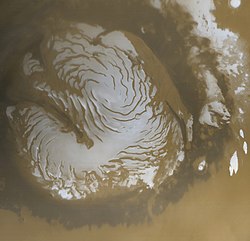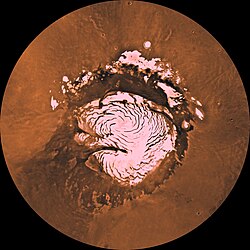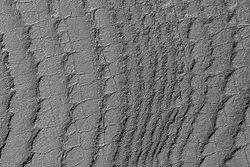North pole of Mars by HiRISE (ESP 035295 2670)
In this image, the winter frosts are about to disappear and we can begin to see the surface features of the ice. The ice cap would be a bad place to get lost: it's one of the smoothest, flattest places on Mars so there are no landmarks visible. The surface features are gently rolling hummocks (or small mounds) and hollows about a metre in height and about 20 metres across. This monotonous landscape continues for hundreds of kilometres in every direction with this same repeating pattern.
Scientists do not know what makes this pattern so uniform over such large distances; we acquire HiRISE images like this one to look for small differences in these icy features from one place to another. Understanding this surface can help us understand the current climate and meteorological conditions at the North Pole of the Red Planet.Relevante Bilder
Relevante Artikel
Polkappen des MarsDer Planet Mars besitzt an seinen beiden Polen auffällige, dauerhafte Eiskappen, die aus gefrorenem Kohlendioxid und Wassereis zusammengesetzt sind. Während der Wintersaison tauchen die Pole in vollständige Dunkelheit, die ein halbes Marsjahr (bzw. 343,5 Tage) andauert. Durch die extreme Kälte resublimieren 25–30 % des gasförmigen Kohlendioxids der dünnen Marsatmosphäre zu Trockeneis. Mit Rückkehr des Sonnenlichts im Sommerhalbjahr sublimiert das gefrorene CO2. Dabei entstehen enorme Windböen, die mit bis zu 400 km/h aus der Polregion herabwehen. Diese saisonbedingten Stürme erzeugen erdähnliche Frostbedingungen und transportieren sehr große Mengen an Staub und Wasserdampf. Durch die höhere Atmosphäre ziehen Cirruswolken. Im Jahr 2004 fotografierte der Rover Opportunity Wolken, die Wassereis enthielten. .. weiterlesen










